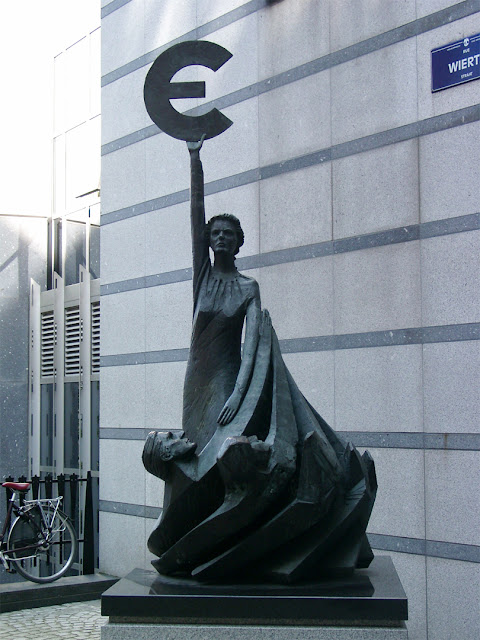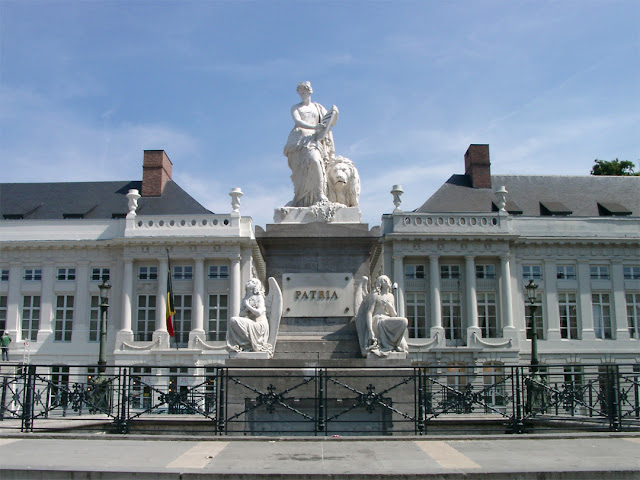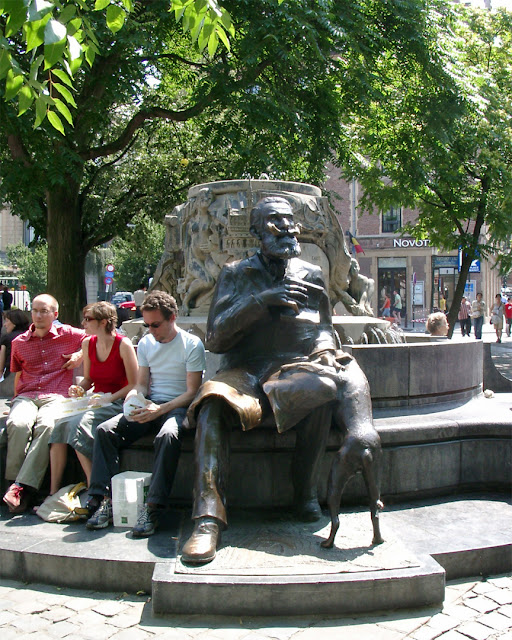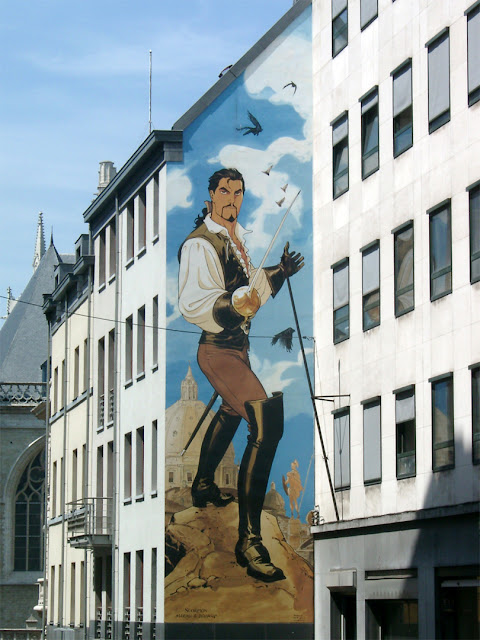Wednesday, December 31, 2008
Tuesday, December 30, 2008
Monday, December 29, 2008
Sunday, December 28, 2008
Egmont en Hoorn
Fountain of the Counts of Egmont and Horn by Charles-Auguste Fraikin
Petit Sablon, Kleine Zavel
Brussels, July 2006
Saturday, December 27, 2008
Europe
“Europe” by May Claerhout
Paul-Henri Spaak building
Espace Léopold
Brussels, July 2006
“The Espace Léopold (French; commonly used in English) or Leopoldruimte (Dutch; About this soundlisten (help·info)) is the complex of parliament buildings in Brussels (Belgium) housing the European Parliament, a legislative chamber of the European Union. It consists of a number of buildings, primarily the oldest, the Paul-Henri Spaak building, which houses the debating chamber and the President's offices, and the Altiero Spinelli building which is the largest. The buildings are located in the European quarter in the east of Brussels, with building starting in 1989. The complex is not the official seat of Parliament, which is the Immeuble Louise Weiss in Strasbourg, France, but as most of the other institutions of the European Union are in Brussels, Parliament built the Brussels complex to be closer to their activities. A majority of the Parliament's work is now geared to its Brussels site, but it is legally bound to keep Strasbourg as its official home.” (Espace Léopold, Wikipedia)
Friday, December 26, 2008
Thursday, December 25, 2008
Wednesday, December 24, 2008
Don Quixote and Sancho Panza
Monument to Cervantes (Don Quixote and Sancho Panza) by Lorenzo Coullaut Valera
(Replica of the 1930 original in Madrid)
Place d’Espagne / Spanjeplein
Brussels, July 2006
Tuesday, December 23, 2008
Monday, December 22, 2008
Sunday, December 21, 2008
Fontaine des aveugles
“Fontaine des aveugles” (Fountain of the Blind Men)
Petite rue au Beurre, Kleine Boterstraat
Brussels, July 2006
Saturday, December 20, 2008
Dexia Tower
Dexia Tower (Tour Dexia)
Saint-Josse-ten-Noode
Brussels, July 2006
“The Rogier Tower (French: Tour Rogier, Dutch: Rogiertoren) is a skyscraper located in the Northern Quarter central business district of Saint-Josse-ten-Noode, Brussels (Belgium). It owes its name to Charles Rogier Square on which it is situated. It was formerly known as the Dexia Tower after Dexia bank, but that bank fell victim to the 2007–2012 global financial crisis and the tower's name was changed on 1 March 2012. As Dexia moved its offices in Brussels to the Bastion Tower in Ixelles, Belfius and its subsidiaries are the only occupants of this tower, often also called the Belfius Tower. It is the fourth tallest building in Belgium. It is built on the site of the Rogier International Centre (French: Centre International Rogier, Dutch: Internationaal Rogiercentrum), also called the Martini Tower, which was formerly the tallest building in Belgium, but was demolished in 2001. Constructed between 2002 and 2006, the Rogier Tower is 137 metres (449 ft) tall. It was originally planned to be 179 metres (587 ft) tall, but the proposal was rejected because the height was thought to be excessive. The Rogier Tower is also one of the few towers in Brussels whose roof is not horizontal, instead being made up of three inclined sections. It is also one of the only towers in the world to have a fully glass roof.” (Rogier Tower, Wikipedia)
Friday, December 19, 2008
Thursday, December 18, 2008
Wednesday, December 17, 2008
Tuesday, December 16, 2008
Maisons de la Grand-Place
Le Marchand d'or, Le Pigeon, La Chaloupe d'or
L'Ange, Joseph et Anne, Le Cerf volant
Grand Place, Grote Markt
Brussels, July 2006
Monday, December 15, 2008
Sunday, December 14, 2008
Everard 't Serclaes
Everard 't Serclaes monument by Julien Dillens
Maison de l'Étoile
Rue Charles Buls
Brussels, July 2006
“Everard t'Serclaes, Lord of Kruikenburg (c. 1320 – 31 March 1388) was a citizen of Brussels who was made famous by his recovery of the city from the Flemings. His brother, Jean, was bishop of Cambrai. After the death of John III of Brabant on 5 December 1355, his daughter Joanna and her husband, Wenceslaus, succeeded him as rulers of the duchy. Their succession was disputed by the count of Flanders, Louis de Male. Louis invaded Brabant and quickly seized Brussels. On the night of 24 October 1356, Everard scaled the city walls leading a group of patriots and drove the Flemings from the city. This enabled Joanna and Wenceslaus to make their Joyous Entry into the city. Everard was later made schepen (alderman) of the city five times. As an old man he led the successful opposition to the selling of a section of crown land to Sweder of Abcoude, lord of Gaasbeek. A group led by Sweder's illegitimate son ambushed, beat, and mutilated Everard on the road from Lennik to Brussels. He died five days later as a result of the attack. In response, the citizens of Brussels, joined by allies from across Brabant, razed Gaasbeek Castle. Everard is commemorated by a monument sculpted by artist Julien Dillens (1849–1904), which is located on Charles Buls street in Brussels, just off the Grand Place. It is said among locals that the statue of Everard t'Serclaes brings luck and grants the wishes of all who touch it. Many tourists touch (or rather rub) the statue, particularly the arm, because legend has it that rubbing the arm will ensure one's return to Brussels. Other parts are also touched frequently by the tourists such as the face of an angel, a dog, and one of the shields. This constant polishing keeps the body shining compared to the rest of the sculpture.” (Everard t'Serclaes, Wikipedia)
Saturday, December 13, 2008
Manneken Pis
“Manneken Pis” by François Duquesnoy
Rue de l'Étuve / Rue du Chêne
(Stoofstraat / Eikstraat)
Brussels, July 2006
Friday, December 12, 2008
Thursday, December 11, 2008
Wednesday, December 10, 2008
Tuesday, December 9, 2008
Le Scorpion
Mural painting “Le Scorpion”
A comic strip by Enrico Marini and Stephen Desberg
Treurenberg
Brussels, July 2006
Monday, December 8, 2008
Henri Alexis Brialmont
Brialmont by Frans Huygelen
Rue de Louvain / Rue Royale
Brussels, July 2006
“Henri-Alexis Brialmont (Venlo, 25 May 1821 – Brussels, 21 July 1903), nicknamed The Belgian Vauban after the French military architect, was a Belgian army officer, politician and writer of the 19th century, best known as a military architect and designer of fortifications. Brialmont qualified as an officer in the Belgian army engineers in 1843 and quickly rose up the ranks. He served as a staff officer, and later was given command of the district of the key port of Antwerp. He finished his careers as Inspector-General of the Army. Brialmont was also an active pamphleteer and political campaigner and lobbied through his career for reform and expansion of the Belgian military and was also involved in the foundation of the Congo Free State. Today, Brialmont is best known for the fortifications which he designed in Belgium and Romania and would influence another in the Democratic Republic of the Congo. The fortifications he designed in Belgium at the end of the 1880s around the towns of Liège, Namur and Antwerp would play an important role during the early stages of the German invasion of Belgium during World War I.” (Henri Alexis Brialmont, Wikipedia)
Sunday, December 7, 2008
Saturday, December 6, 2008
Friday, December 5, 2008
Fontaine de la Trinité
Fontaine de la Trinité (or Notre-Dame) by Barnabée Guimard (rebuilt in 2005)
Place de la Chapelle
Brussels, July 2006
Thursday, December 4, 2008
Wednesday, December 3, 2008
Tuesday, December 2, 2008
Monday, December 1, 2008
Monument aux forains
Monument aux forains (Fair stall holders)
who died in the two World Wars
Boulevard Poincaré
Brussels, July 2006
Subscribe to:
Posts (Atom)































